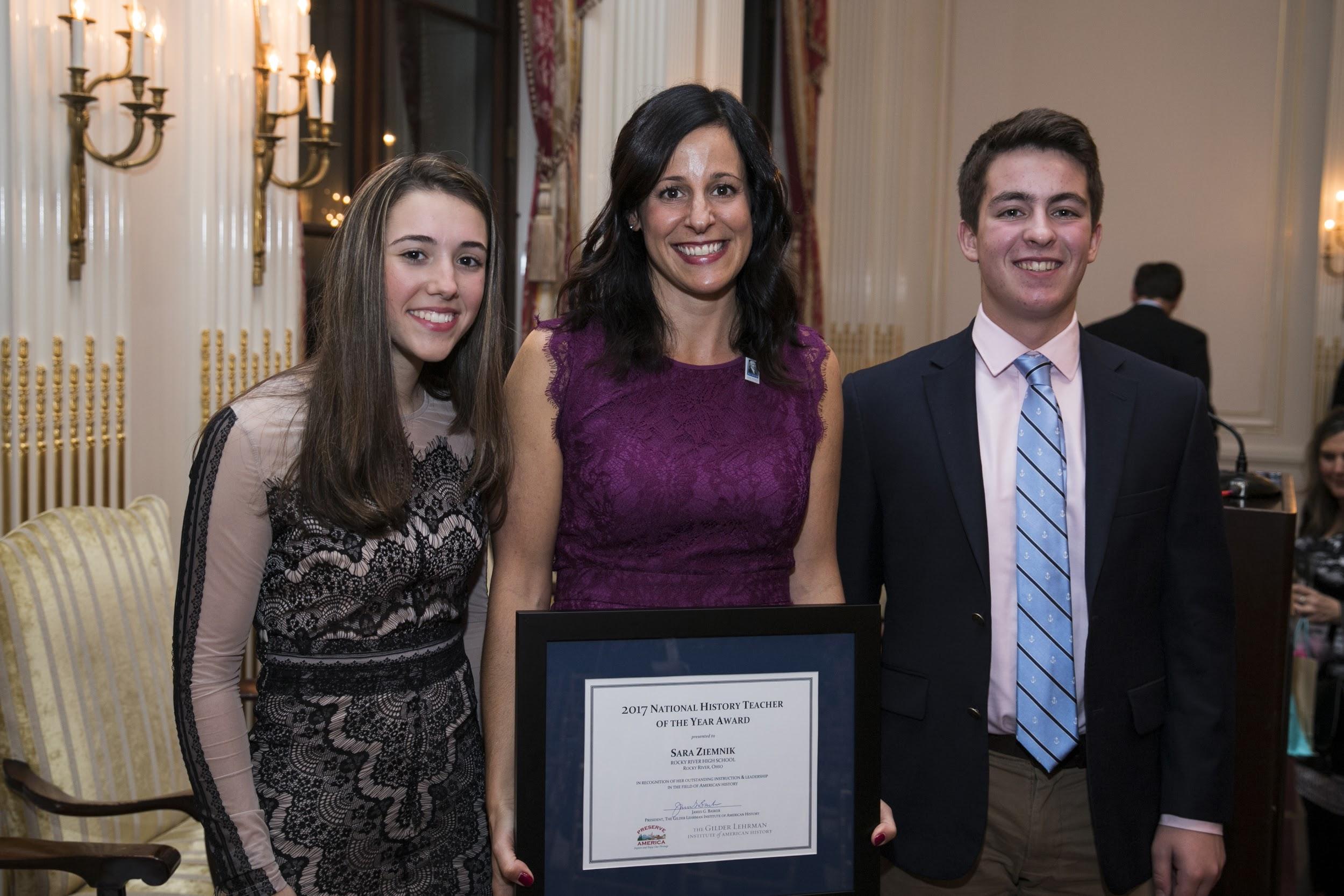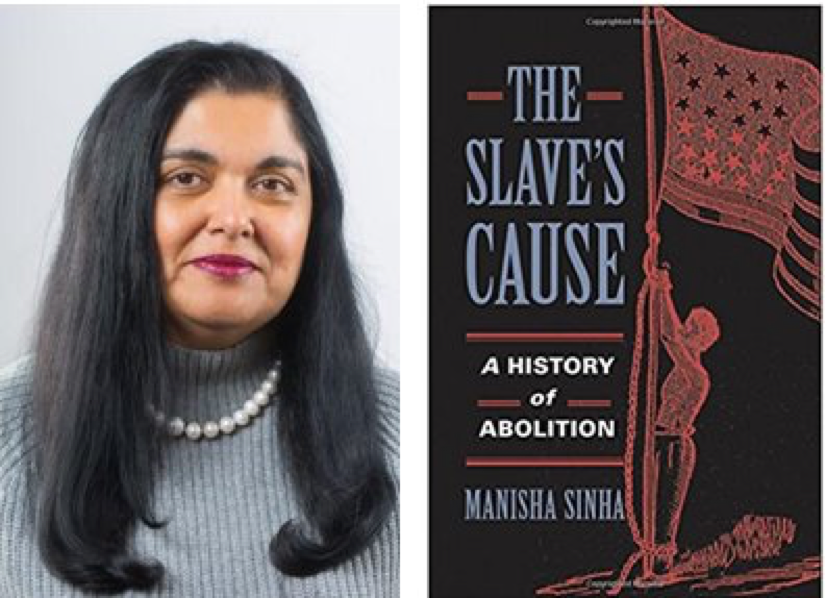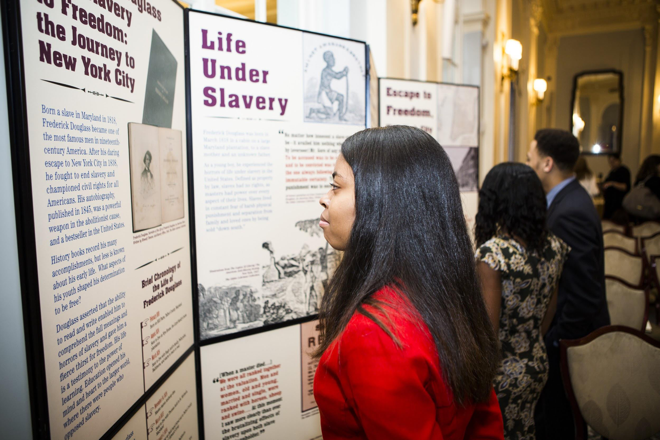GLI Now - Winter 2018 Newsletter
Sara Ziemnik: 2017 National History Teacher of the Year

On November 8, Sara Ziemnik was honored as the Gilder Lehrman Institute’s 2017 National History Teacher of the Year at a ceremony in New York City. Pulitzer Prize–winning historian Eric Foner presented Ziemnik with her award and a prize of $10,000 in front of 150 guests at the University Club of New York City.
Ziemnik has taught American history and world history for seventeen years at Rocky River High School in Ohio, where she centers her students’ experience around discussion and inquisitive learning. She encourages her students to learn from one another and works with the local community, as seen in one of her projects with Cleveland State University. Students created and added content to the “Cleveland Historical” app, where users can explore Cleveland history via interactive tours.
 In accepting her award, Ziemnik spoke of the importance of bringing controversial topics, past and present, into the classroom as a way to encourage students to form their own opinions based on evidence and to engage in respectful dialogue.
In accepting her award, Ziemnik spoke of the importance of bringing controversial topics, past and present, into the classroom as a way to encourage students to form their own opinions based on evidence and to engage in respectful dialogue.
“Any silence [is] a statement . . . and silence is a dangerous choice,” she told the packed room of teachers, students, historians, and other friends of the Institute. Having difficult discussions, according to Ziemnik, helps students grow into civic-minded and politically engaged adults able to think critically and form educated opinions.
As part of this year’s award, Ziemnik’s school hosted Professor Charles McKinney of Rhodes College for an interactive workshop for students and teachers on Reconstruction and Modern Day Social Movements.
In an interview with Rick Hess, author of a popular education blog published in Education Week, “Rick Hess Straight Up,” Ziemnik discussed her passion for history and her award-winning approach in the classroom. When asked about her pedagogical philosophy, Ziemnik explained that her own studies and experiences “helped me focus on creating engaging, content-rich, and student-driven lessons that illustrate to my students how the past is influencing their lives every day.” Read the entire article here: Straight Up Conversation: 2017 National History Teacher of the Year Sara Ziemnik.
$2.2 Million in Federal Government Grants Awarded to the Institute

The Gilder Lehrman Institute of American History is proud to announce that it was awarded two prestigious grants: a $1.8 million grant from the US Department of Education (USDOE) to expand its teacher professional development work in California, and a $400,000 grant from the National Endowment for the Humanities (NEH) to launch a nationwide library outreach program about the Founding Era. The Institute was the only organization to receive the USDOE grant, selected from a total of 65 applicants.
***
Funds from the USDOE grant will support A More Perfect Union, a three-year, K–12 professional development program for teachers in California. Elementary, middle, and high school teachers from Del Norte and Humboldt Counties and the Los Angeles Unified School District will participate in 100 hours of professional development that will strengthen their knowledge of American history, civics/government, and geography, as well as increase their ability to use research-based instructional practices. Upon completing A More Perfect Union, these teachers will have the tools to lead their students through the reading and interpretation of primary historical sources and the exploration of multiple perspectives, by teasing out arguments, examining the factual basis of those arguments, and developing their own critical thinking abilities.
The program is designed to combine group workshops, individual coaching sessions, and digital resources to develop new ways of reaching teachers who serve a wide variety of rural, suburban, and urban students. Through this program, teachers will participate in live interactive sessions with eminent historians such as Carol Berkin and use Gilder Lehrman’s Self-Paced Courses to enhance their knowledge of specific themes in American history.
A More Perfect Union will expand the work the Institute has been doing for more than two decades in American history education, because we believe the path to a more perfect union begins with an educated and civically engaged population. We anticipate that these 250 educators will impact approximately 15,000 students over the three-year program.
***
The grant awarded by the NEH will enable the Institute to bring Revisiting the Founding Era, a three-year program hosted by 100 public libraries across the country. The primary goal is to encourage an appreciation of the country’s past through community conversations about the Founding Era and its relevance today.
Revisiting the Founding Era will provide print and digital resources to help librarians and community leaders become familiar with the people, events, and overarching themes of the Founding Era. Working in partnership with the American Library Association and the National Constitution Center, the Gilder Lehrman Institute has enlisted four leading scholars of the era, and the curators of the Gilder Lehrman Collection, to compile a reader of twenty seminal documents. This 100-page reader will provide essays by the scholars and questions for discussion, and introduce the words and deeds of people often left out of the Founding Era narrative—women, African Americans, and ordinary Americans who participated in and were affected by great events from 1760 to 1800.
The Institute also plans to make thousands of copies of the reader available to teachers and students throughout the Institute’s Affiliate School Network, which by 2021 will include almost 30,000 schools, touching the lives of five million students each year. In addition to the reader, which will be available in print and digital formats, participants will have access to online resources and digital tools through a public-facing website with additional primary sources, videos, and links to materials on the Gilder Lehrman Institute website.
We hope to inspire not just the young but every generation to examine and appreciate the struggles, contributions, and legacies of the founders, and to engage with a renewed sense of purpose in the civic life of their community and their country today. - James G. Basker, President of the Gilder Lehrman Institute of American History.
19th Annual Frederick Douglass Book Prize: Celebrating an Outstanding Historian and Commemorating the 200th Birthday of Frederick Douglass

On February 22, the Gilder Lehrman Institute of American History, in collaboration with the Gilder Lehrman Center for the Study of Slavery, Resistance, and Abolition at Yale University, will host the 19th annual Frederick Douglass Book Prize celebration. This prize recognizes an outstanding historian and their new book about slavery, resistance, or abolition. The winner is awarded $25,000, underwritten by the Institute, and is honored at a ceremony at the Yale Club in New York City. This award has previously recognized the work of such renowned scholars as David W. Blight, Christopher L. Brown, and Stephanie Smallwood.
Professor Manisha Sinha, the James L. and Shirley A. Draper Chair in American History at the University of Connecticut, was selected as the winner of the 2017 Frederick Douglass Book Prize for The Slave’s Cause: A History of Abolition (Yale University Press). Professor Sinha’s book was chosen from a field of eighty nominations. “Sinha’s work is a great scholarly achievement, placing black abolitionists and the fate of fugitive slaves at the center of the story of this country’s prototypical radical reform movement,” said Gilder Lehrman Center Director David W. Blight, Class of 1954 Professor of American History at Yale.
This summer Professor Sinha will be the lead historian and teacher for "Slavery and Abolition," one of 30 Teacher Seminars offered by the Institute annually. Hosted at Columbia University, in partnership with The Lapidus Center for the Historical Analysis of Transatlantic Slavery, this weeklong professional development program will explore the anti-slavery movement from the American Revolution to the Civil War. This will be Professor Sinha’s first time leading a Gilder Lehrman Teacher Seminar.
 At the ceremony on February 22, students from Title I schools, eminent historians, teachers, and history lovers will celebrate the study of African American history and its centrality to the story of America. Because we want this event to be as inclusive as possible, all guests attend for free.
At the ceremony on February 22, students from Title I schools, eminent historians, teachers, and history lovers will celebrate the study of African American history and its centrality to the story of America. Because we want this event to be as inclusive as possible, all guests attend for free.
This year’s Frederick Douglass Book Prize event is particularly meaningful because February 2018 marks the 200th anniversary of the birth of Frederick Douglass. In honor of this milestone and our commitment to recognizing the contributions of African Americans in our country’s history, the Gilder Lehrman Institute is publishing Frederick Douglass: A Life in Documents, a unique collection of more than a dozen Douglass documents from the Gilder Lehrman Collection. Each is introduced by a leading scholar. The contributors to this anthology include David Blight, Leigh Fought, James O. Horton, Lois Horton, Randall Kennedy, Steven Mintz, Lucas Morel, Quandra Prettyman, and Manisha Sinha, among others.
In addition, the Gilder Lehrman Institute has devoted the fiftieth issue of its online journal, History Now, to the life, writings, and legacy of Frederick Douglass. The issue, “Frederick Douglass at 200,” features essays by Adele Alexander, Robert S. Levine, Chandra Manning, Manisha Sinha, and other authorities on the great African American abolitionist and his world.
Gilderlehrman.org Redesigned
After more than six months of intensive review, redesign, and testing, the Institute launched its updated website in early December. While still a work in progress, millions of users will be able to access the Institute’s rich trove of online content through more intuitive navigation and a robust search function. Teachers may use the site to register for seminars or search for particular lesson plans, while students may take advantage of free AP US History study guide or submit a Student Essay Contest entry. The new site’s structure clearly and efficiently organizes content so users can locate the specific material most relevant to their needs.
More and more people are relying on mobile devices to surf the internet, rather than browsing content on computers, which is why the new site is now easily accessible on both smart phones and tablets. These changes to our site ensure that teachers, students, historians/writers, and the general public enjoy an efficient and meaningful experience every time they visit us on the web. We project that the improved user experience will engage and serve more unique visitors year after year.
Gilder Lehrman Digital Collection Now Offered at a Discounted Rate for K–12 Schools

The Gilder Lehrman Collection is at the Institute’s core. Nearly 70,000 letters, diaries, maps, newspapers, photographs, and other items dating back to the 15th century document our country’s political, social, and economic history. With a focus on primary sources, the Institute illuminates the stories, lives, and moments that inspire students of all ages and backgrounds to learn and understand more about history. Today, the Institute is proud to offer K–12 schools affordable online subscriptions to the Collection through Adam Matthew Digital, a digital publisher specializing in unique primary source collections from archives around the world.
GLI’s partnership with Adam Matthew Digital, which began in 2015, now makes 59,000 documents from our Collection available as a resource database (entitled “American History, 1493–1945”) to universities, schools, and libraries worldwide. Subscribers receive access to detailed catalog entries, high-resolution images, and advanced search capabilities that they will not find on gilderlehrman.org. Major subscribers to “American History, 1493–1945” include Harvard, Yale, and the Library of Congress.
In fall 2017, the Institute and Adam Matthew Digital, which normally markets the full subscription at $48,000 a year, introduced a substantially reduced and simplified subscription model exclusively for primary and secondary schools in order to give them a more realistic opportunity to incorporate this world-class resource into their classroom learning. It is the Institute’s goal to have 100 schools subscribe by the end of 2018.